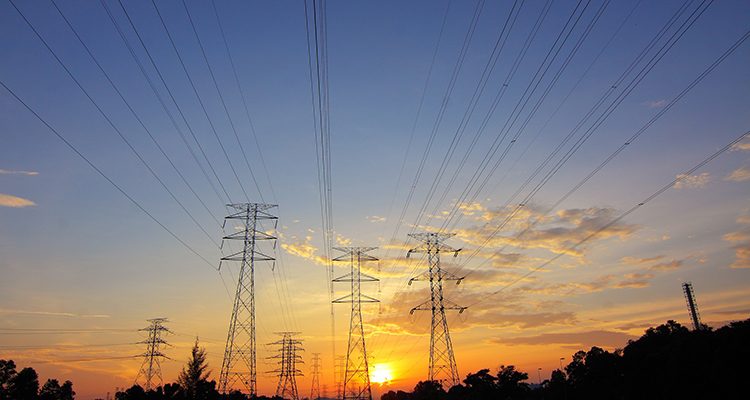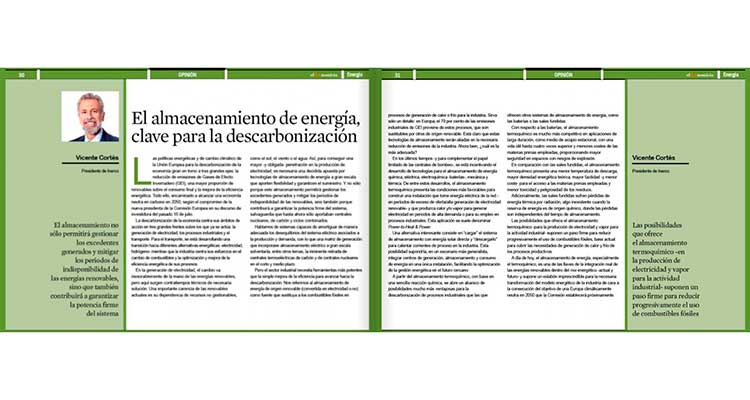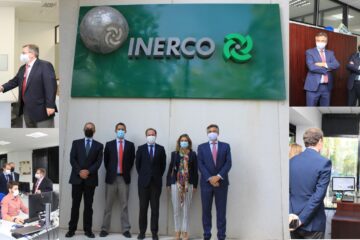Energy storage, key to decarbonisation

Prof. Vicente J. Cortés, presidente de INERCO
(Fuente: Especial Energía ‘El Economista’)

The energy and climate change policies of the European Union for the decarbonisation of the economy revolve around three main axes: the reduction of Greenhouse Gas (GHG) emissions, a greater proportion of renewables in end consumption and improvement of energy efficiency.
All this is intended to achieve a carbon neutral economy in 2050, according to the commitment made by the new president of the European Commission in her opening speech on 16 July.
The decarbonisation of the economy focuses its areas of action on three main fronts on which it already acts: electricity generation, industrial processes and transport. For transport, a transition to different energy alternatives (electricity, hydrogen) is being developed while the industry focuses its efforts on changing fuels and optimising and improving the energy efficiency of its processes.
In electricity generation, change inexorably goes hand in hand with renewable energies, but technical problems arise at this point that need solving. A major drawback of current renewables is their dependence on unmanageable resources, such as the sun, wind or water. Thus, to achieve a greater – and forced – penetration into electricity production, it is necessary to make a determined commitment to large-scale energy storage technologies that offer flexibility and guarantee supply.
And not only because this storage will make it possible to manage the surpluses generated and mitigate the periods when renewables are unavailable, but also because it will contribute to guaranteeing the firm capacity of the system, a safeguard that until now has only been provided nuclear, coal and combined cycle power plants.
We are talking about systems capable of adequately absorbing the electrical system imbalances associated with production and demand, so that a generation mix incorporating large-scale electrical storage would solve, among other matters, the imminent withdrawal of coal-fired thermoelectric power plants and nuclear power plants in the short and medium term.
But the industrial sector needs more powerful tools than simply improving efficiency to move towards decarbonisation. We are referring to the storage of renewable energy (whether converted into electricity or not) as a source to replace fossil fuels in heat or cold generation processes for industry. Let this detail suffice: in Europe, 70 percent of industrial GHG emissions come from these processes, which can be replaced by others of renewable origin.
It is clear that these storage technologies will be allies in the necessary reduction of emissions in industry. Now, which is the most suitable?
In recent times – and to complement the limited role of pumped storage power plants – the development of energy storage technologies is being incentivised: chemical, electrical, electrochemical – batteries -, mechanical and thermal. Among these developments, thermochemical storage has the most favourable conditions for building a facility that takes electricity from the grid – in periods of excess supply / high generation of renewable electricity – and which produces heat and/or steam to generate electricity in periods of high demand or for use in industrial processes. This application is normally called Power-to-Heat & Power.
An interesting alternative is to “charge” the storage system with direct solar energy and “discharge it” to heat process currents in industry. This possibility would involve, in a more generalist scenario, integrating energy generation, storage and consumption centres into a single facility, making it easier to optimise energy generation in the near future.
Thermochemical storage, based on a simple chemical reaction, opens a range of much more advantageous possibilities for decarbonising industrial processes than those offered by other energy storage systems, such as batteries or molted salts.
With respect to batteries, thermochemical storage is much more competitive in long-term applications, as a means of seasonal stockpiling, with a shelf life up to four times longer and cheaper raw materials, which offers greater safety in spaces with a risk of explosion.
In comparison with molten salts, thermochemical storage has a lower discharge temperature, higher theoretical energy density, greater ease – and a lower cost – in accessing the raw materials used and lower toxicity and hazard in the waste products.
Additionally, molten salts undergo losses of thermal energy due to radiation, which is not the case when the energy reserve is of chemical origin, where the losses are independent of the storage time.
The possibilities offered by thermochemical storage – for electricity production and steam for industrial activity – are a strong step in the direction of gradually reducing the use of fossil fuels, the current basis for meeting the heat and cold generation needs in production processes.
Today, energy storage, especially thermochemical energy storage, is one of the keys to the real integration of renewable energies into the energy mix – current and future – and is an essential link in the necessary transformation of industry’s energy model with a view to achieving the goal of a climate neutral Europe in 2050, which the Commission will propose shortly.






